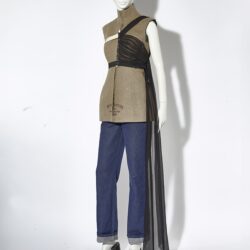Meet SOFT? artist: Anton Cotteleer

Anton Cotteleer transforms human and animal shapes into alienating sculptures. Recently Cotteleer completed his research project, ‘The Skin of Sculpture’ at the Royal Academy of Fine Arts in Antwerp.
Jouw beelden herken je meteen aan een zachte, pluizige huid. Het maakt ze tastbaarder dan ‘klassieke beelden’ en daarom ook menselijker. Hoe kwam je tot dit proces?
Huiselijkheid is al langer een belangrijk gegeven binnen mijn werk. Vroeger kreeg dit de vorm van getransformeerde objecten uit interieurs, vandaag combineer ik dat vaak met een vervormde figuratie. De stoffige ‘huiden’, zoals tapis-plain en gordijnen, die deel uitmaakten van vroegere werken probeer ik op deze nieuwe figuratie toe te passen. Via verschillende experimenten ben ik op mijn huidige flock-techniek uitgekomen (een techniek waarbij minuscule deeltjes stof, vaak elektrostatisch geladen, aangebracht worden op een andere materie). Het werk ‘Don’t play with the poodle’ is het eerste werk waarbij ik een zachtere huid gebruikt heb. Naast de stofachtige geflockte huiden werk ik ook regelmatig met andere zachtere materialen zoals siliconen.
Your sculptures are immediately recognizable because of their soft, fluffy skin. It makes them more tangible than ‘classical sculptures’ and therefore somewhat more human. How did you come up with this process?
Domestic settings have always been an important source of inspiration in my work. In the past, this resulted in transformed objects from interiors, today I often combine this with a distorted figuration. I try to apply dusty ‘skins’ such as fitted carpet and curtains that were part of earlier works to this new figuration. Through various experiments I ended up with the flock technique that I currently use (a technique to apply miniscule particles of fabric on a different surface by electrically charging them). The work ‘Don’t play with the poodle’ is the first work I gave a soft skin. In addition to these flocked skins, I also regularly work with other soft materials such as silicones.

What role do textiles play in your work?
Textiles have played a major role over the last nine years. The textiles that I use for objects and pedestals are usually from my own archive that I collected from family members. When I have a specific fabric in mind, I search for it on the internet or in second-hand shops. New fabrics don’t interest me that much.Your main source of inspiration are Flemish living rooms with their typical artifacts, carpets, textiles and decorations that set the mood.
Your main source of inspiration are Flemish living rooms with their typical artifacts, carpets, textilesand decorations that set the mood. Where does this fascination come from?
My love for typical Flemish interiors probably stems from my childhood. When you are a kid, colours, smells and shapes are more intense. Nowadays, I often work with materials and interiors that I had to avoid as a child because of asthma problems. I always try to work with contrasts. For example, I like to contrast my rather erotic figuration with “kneuterige”, or grannylike, interiors.

Where does this fascination come from?
My love for typical Flemish interiors probably stems from my childhood. When you are a kid, colours, smells and shapes are more intense. Nowadays, I often work with materials and interiors that I had to avoid as a child because of asthma problems. I always try to work with contrasts. For example, I like to contrast my rather erotic figuration with “kneuterige”, or grannylike, interiors.
How do you discover these typical Flemish interiors on which your work is based?In the past I was able to rely on the houses of family members, but now that they have passed away, I have to step out in the world. I follow my gut feeling and talk to strangers of whom I suspect that their homes might be interesting to me. This is very uncomfortable at times, but it is just part of the game. These actions are also part of the research project ‘De Ongemakkelijke Omgeving’ (The Uncomfortable Environment) at the Royal Academy of Fine Arts Antwerp. Afterwards, I photograph my sculptures in the interiors on which they are partly inspired. This experience and confrontation are very intense and valuable to me.
You never present your sculptures on heavy marble pedestals, but rather on pieces of furniture with light feet.
The presentation on furniture or manipulated pedestals brings the work closer to the viewer. A heavy pedestal in classical sculpture suggests that you are dealing with an elevated work of art and I try to limit that feeling.
SOFT? Tactile Dialogues from 28.09.2018 - 24.02.2019 on location at Maurice Verbaet Center


